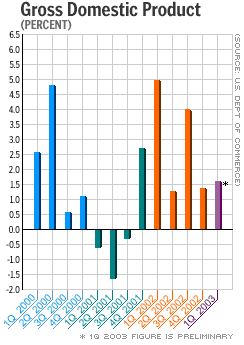NEW YORK (CNN/Money) -
Most experts think the economy's rebound to full strength is just a month or two away.
After all, there's a powerful cocktail of stimulus in the shaker -- everything from a falling dollar to tax cuts to low interest rates -- to give the world's largest economy a boost.
But some bearish economists are warning that we've heard these forecasts more than once before, that the forecasts have been wrong every time, and that there's little to indicate they're right this time.
"The principal forecast has been the mañana forecast," said former Federal Reserve economist Lacy Hunt, now chief economist with Hoisington Investment Management in Austin, Tex. Mañana is the Spanish word for "tomorrow," which is when forecasters have consistently said the U.S. economy would get back to full strength.
What's different this time?
On Thursday the government is due to issue its revision of first-quarter gross domestic product (GDP), the broadest measure of the nation's economy, with analysts betting the number will be raised to a 1.9 percent growth rate, on average, from the Commerce Department's initial reading of 1.6 percent, according to a Reuters poll.

But even 1.9 percent GDP growth is lousy. Look at the five years ending in 1994, during which the economy sank into recession and then struggled to recover, but still managed to claw ahead at a 2.2 percent annual rate, on average.
Most economists think 3.5 percent growth is necessary to bring unemployment down. The U.S. economy hasn't managed to put together two straight quarters like that since the third and fourth quarters of 1999, when unemployment was at 4 percent. Since then, unemployment has jumped to 6 percent.
But take heart, many economists say. On average, forecasters predict 3.4 percent GDP growth in both the third and fourth quarters, according to the Philadelphia Fed's latest survey of 37 economists. But these forecasters have been wrong before -- more than once, in fact.
When surveyed at the start of 2001, forecasters predicted 3.6 percent GDP growth for all of 2002; GDP actually grew just 2.4 percent in 2002. When surveyed at the start of 2002, forecasters predicted 3.5 percent growth in 2003. Lately, they've cut their forecast for the year to 2.2 percent.
Now, they're expecting 3.6 percent GDP growth in 2004. Why are they right this time, when they were wrong before?
In response, these economists point to:
- tax cuts, signed into law Wednesday by President Bush, which he claims will boost consumer spending, stock prices and business investment
- interest rates at 40-year lows, making borrowing costs cheap
- the falling dollar, which should help boost U.S. exports and exporters' profits
- rising consumer confidence
- rising stock prices
"With all that as a backdrop, there are some real positive forces to stimulate growth," said Anthony Chan, chief economist at Banc One Investment Advisors.
And there had better be. Chan noted that when he averaged GDP growth in every quarter since 1948, he found that seasonal factors made the third and fourth quarters the weakest of the year.
And some economists doubt the stimulus in the pipeline will be enough to fight the negative seasonal factors. According to them:
- much cash from the tax cuts will be saved, or spent on imported goods, which does zilch for GDP
- low interest rates help little if businesses won't or can't borrow and if consumers lose their appetite for new houses and cars
- China's the biggest exporter of cheap goods to the U.S. and its currency is pegged to the dollar, so a falling dollar actually helps make that country's exports more competitive
- consumer confidence and stocks have risen before during this prolonged weak recovery, with little effect
"With all this stimulus, we've had very little to show for it," said Robert Brusca, chief economist at Native American Securities. "Something seems to have been short-circuiting it."
Though the economy seems unlikely to fall into recession, a prolonged period of sluggish growth, when policy makers' best efforts fail to create jobs, could weaken already shaky consumer and business confidence, Brusca warned.
| Related stories
|

|
|
|
|
And even prolonged economic weakness -- not recession, but weakness -- could trigger deflation, an unstoppable drop in prices that cripples corporate profits and starts a cycle of deteriorating economic strength. See Japan for details.
"If the economy continues to muddle through at around 2 percent annualized growth, we could very well slip into deflation in the next two years," Merrill Lynch chief economist David Rosenberg said in a recent research note.
Businesses in no hurry to spend or hire
Lakshman Achuthan, managing director of the Economic Cycle Research Institute, a private research firm, says he doubts deflation will come unless several recessions hit the economy in a row -- and he sees no sign of this. But he also notes that consumers are supporting the economy while businesses remain on the sidelines, where they will stay, he believes, until demand forces them to boost production.
Since demand seems unlikely to zoom any time soon, production capacity will have to deteriorate -- as machines break down, computers become obsolete and workers leave -- in order to trigger another round of business spending and hiring.
"It may simply take time for this excess capacity to be worked off," he said, adding that he believes it all adds up to "a sub-par recovery -- which is corroborated by the leading indexes we watch."

|

